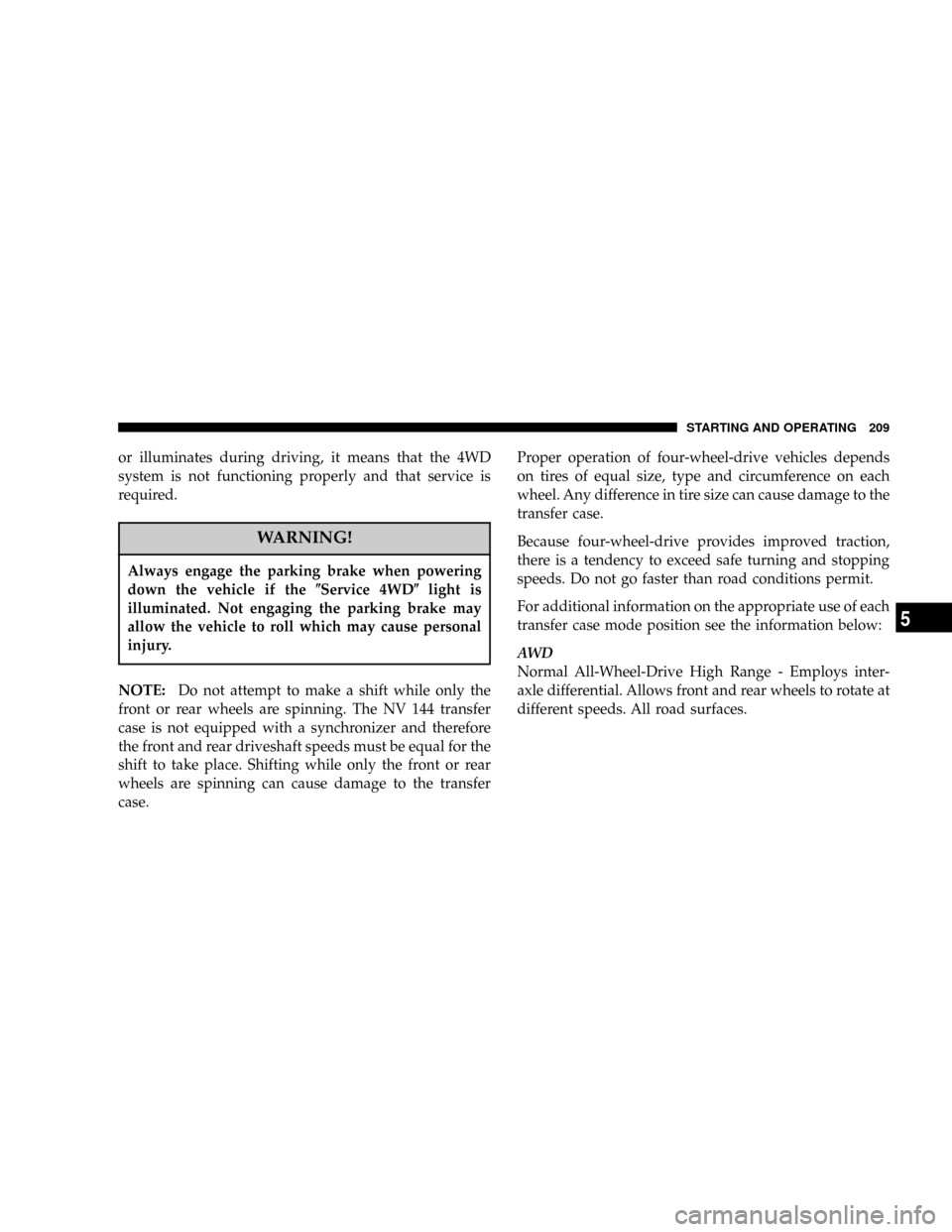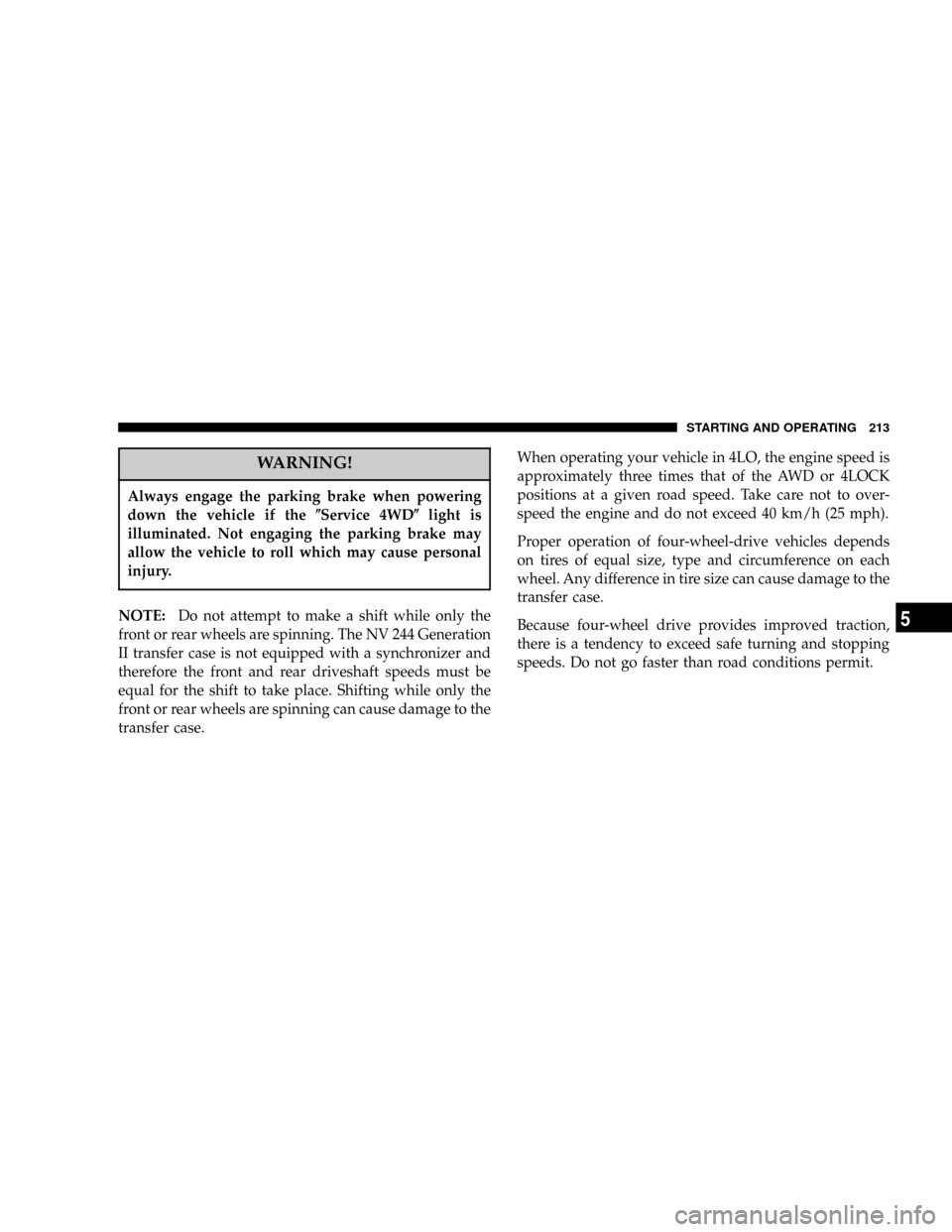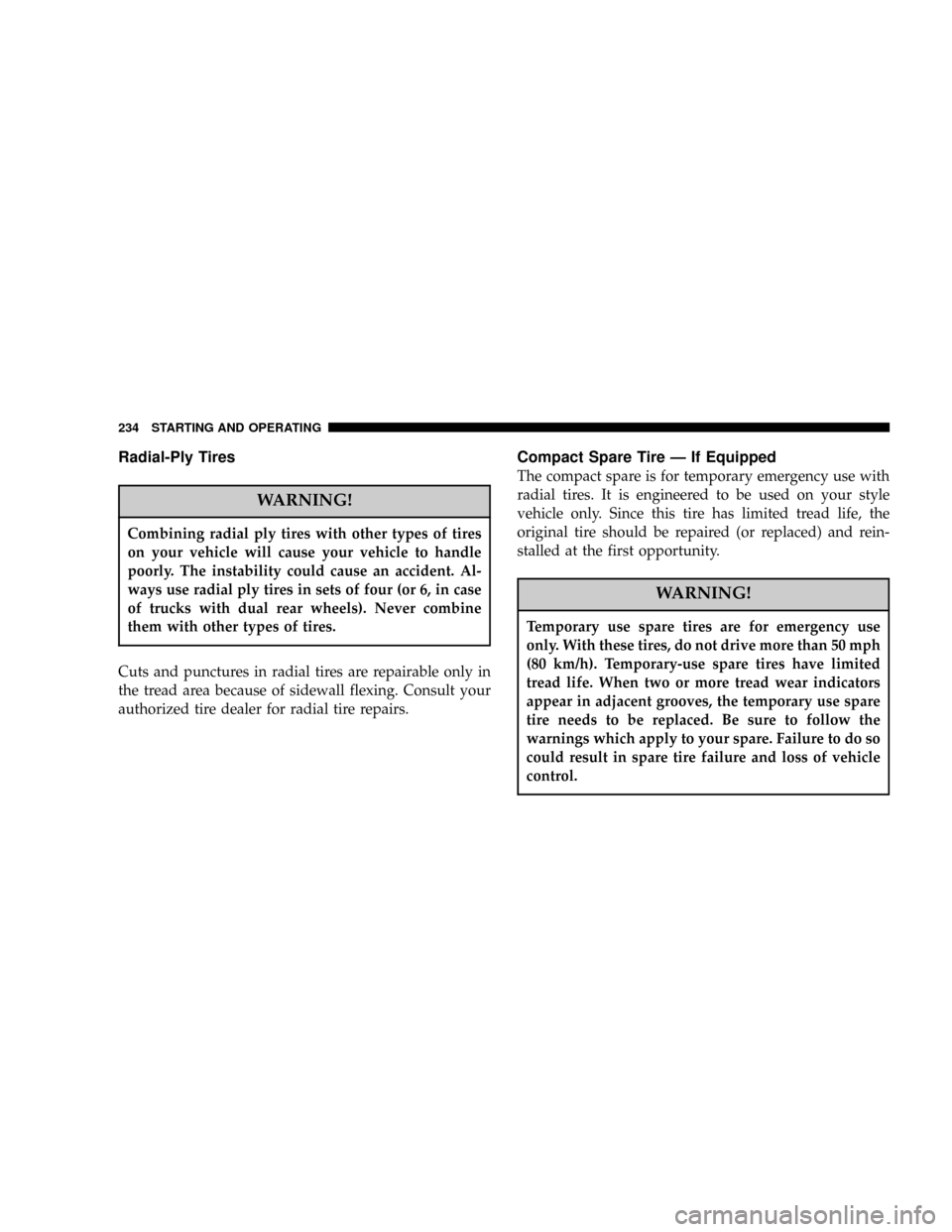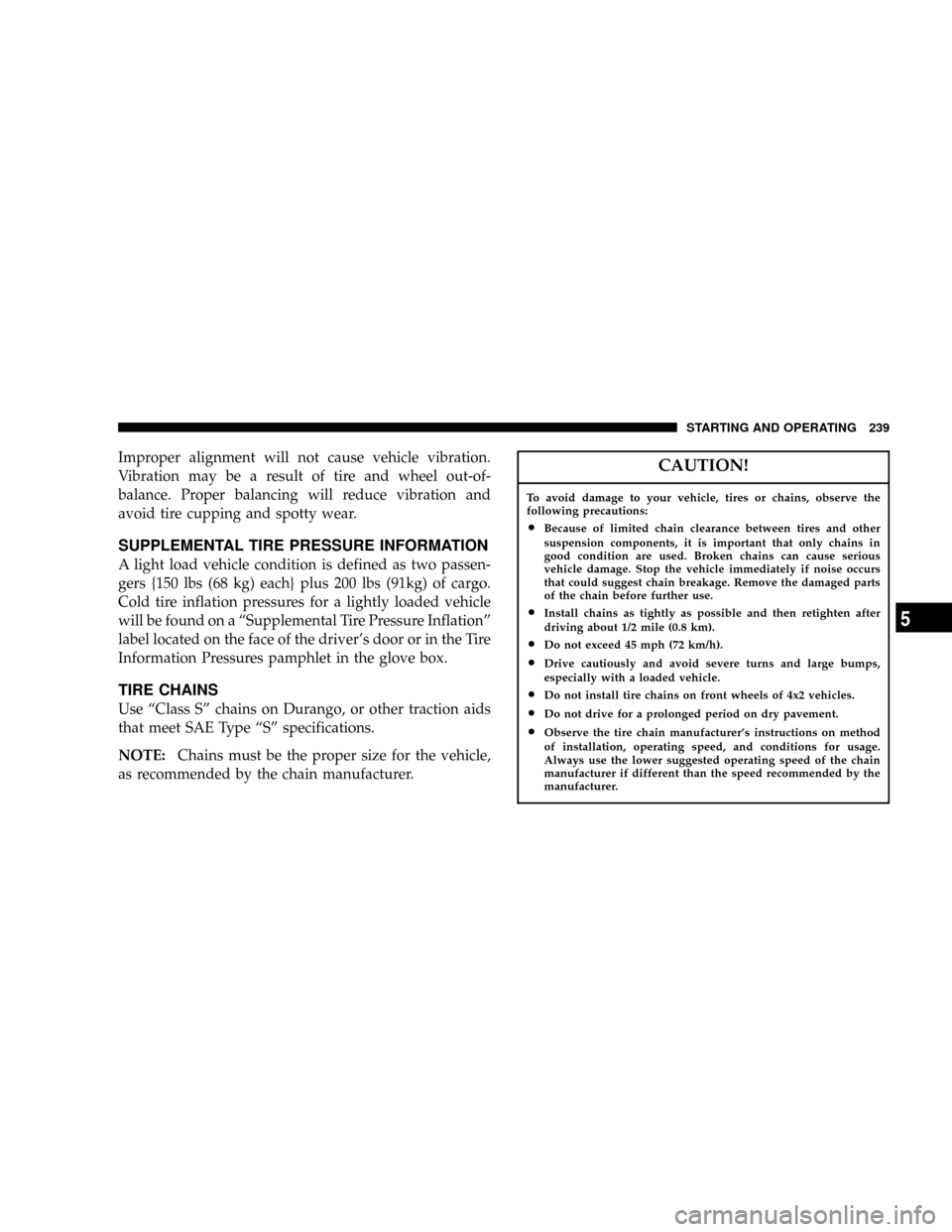tire type DODGE DURANGO 2004 2.G Owners Manual
[x] Cancel search | Manufacturer: DODGE, Model Year: 2004, Model line: DURANGO, Model: DODGE DURANGO 2004 2.GPages: 386, PDF Size: 6.22 MB
Page 209 of 386

or illuminates during driving, it means that the 4WD
system is not functioning properly and that service is
required.
WARNING!
Always engage the parking brake when powering
down the vehicle if the(Service 4WD(light is
illuminated. Not engaging the parking brake may
allow the vehicle to roll which may cause personal
injury.
NOTE:Do not attempt to make a shift while only the
front or rear wheels are spinning. The NV 144 transfer
case is not equipped with a synchronizer and therefore
the front and rear driveshaft speeds must be equal for the
shift to take place. Shifting while only the front or rear
wheels are spinning can cause damage to the transfer
case.Proper operation of four-wheel-drive vehicles depends
on tires of equal size, type and circumference on each
wheel. Any difference in tire size can cause damage to the
transfer case.
Because four-wheel-drive provides improved traction,
there is a tendency to exceed safe turning and stopping
speeds. Do not go faster than road conditions permit.
For additional information on the appropriate use of each
transfer case mode position see the information below:
AW D
Normal All-Wheel-Drive High Range - Employs inter-
axle differential. Allows front and rear wheels to rotate at
different speeds. All road surfaces.
STARTING AND OPERATING 209
5
Page 213 of 386

WARNING!
Always engage the parking brake when powering
down the vehicle if the(Service 4WD(light is
illuminated. Not engaging the parking brake may
allow the vehicle to roll which may cause personal
injury.
NOTE:Do not attempt to make a shift while only the
front or rear wheels are spinning. The NV 244 Generation
II transfer case is not equipped with a synchronizer and
therefore the front and rear driveshaft speeds must be
equal for the shift to take place. Shifting while only the
front or rear wheels are spinning can cause damage to the
transfer case.When operating your vehicle in 4LO, the engine speed is
approximately three times that of the AWD or 4LOCK
positions at a given road speed. Take care not to over-
speed the engine and do not exceed 40 km/h (25 mph).
Proper operation of four-wheel-drive vehicles depends
on tires of equal size, type and circumference on each
wheel. Any difference in tire size can cause damage to the
transfer case.
Because four-wheel drive provides improved traction,
there is a tendency to exceed safe turning and stopping
speeds. Do not go faster than road conditions permit.
STARTING AND OPERATING 213
5
Page 231 of 386

2. EconomyÐ
Improper inflation pressures can cause uneven wear
patterns to develop across the tire tread. These abnormal
wear patterns will reduce tread life resulting in a need for
earlier tire replacement. Underinflation also increases tire
rolling resistance and results in higher fuel consumption.
3. Ride Comfort and Vehicle StabilityÐ
Proper tire inflation contributes to a comfortable ride.
Overinflation produces a jarring and uncomfortable ride.
Tire Inflation Pressures
The proper cold tire inflation pressure for passenger cars
is listed on either the face of the driver's door or the
driver's side ªBº pillar. For vehicles other than passenger
cars, the cold tire inflation pressures are listed on either
the ªBº pillar, the Certification Label or in the Tire
Inflation Pressures brochure in the glove compartment.
Some vehicles may have Supplemental Tire Pressure
Information for vehicle loads that are less than themaximum loaded vehicle condition. These pressure con-
ditions will be found in the ªSupplemental Tire Pressure
Informationº section of this manual.
The pressure should be checked and adjusted as well as
inspecting for signs of tire wear or visible damage at least
once a month. Use a good quality pocket-type gauge to
ªBº PILLAR
STARTING AND OPERATING 231
5
Page 234 of 386

Radial-Ply Tires
WARNING!
Combining radial ply tires with other types of tires
on your vehicle will cause your vehicle to handle
poorly. The instability could cause an accident. Al-
ways use radial ply tires in sets of four (or 6, in case
of trucks with dual rear wheels). Never combine
them with other types of tires.
Cuts and punctures in radial tires are repairable only in
the tread area because of sidewall flexing. Consult your
authorized tire dealer for radial tire repairs.
Compact Spare Tire Ð If Equipped
The compact spare is for temporary emergency use with
radial tires. It is engineered to be used on your style
vehicle only. Since this tire has limited tread life, the
original tire should be repaired (or replaced) and rein-
stalled at the first opportunity.
WARNING!
Temporary use spare tires are for emergency use
only. With these tires, do not drive more than 50 mph
(80 km/h). Temporary-use spare tires have limited
tread life. When two or more tread wear indicators
appear in adjacent grooves, the temporary use spare
tire needs to be replaced. Be sure to follow the
warnings which apply to your spare. Failure to do so
could result in spare tire failure and loss of vehicle
control.
234 STARTING AND OPERATING
Page 239 of 386

Improper alignment will not cause vehicle vibration.
Vibration may be a result of tire and wheel out-of-
balance. Proper balancing will reduce vibration and
avoid tire cupping and spotty wear.
SUPPLEMENTAL TIRE PRESSURE INFORMATION
A light load vehicle condition is defined as two passen-
gers {150 lbs (68 kg) each} plus 200 lbs (91kg) of cargo.
Cold tire inflation pressures for a lightly loaded vehicle
will be found on a ªSupplemental Tire Pressure Inflationº
label located on the face of the driver's door or in the Tire
Information Pressures pamphlet in the glove box.
TIRE CHAINS
Use ªClass Sº chains on Durango, or other traction aids
that meet SAE Type ªSº specifications.
NOTE:Chains must be the proper size for the vehicle,
as recommended by the chain manufacturer.
CAUTION!
To avoid damage to your vehicle, tires or chains, observe the
following precautions:
²Because of limited chain clearance between tires and other
suspension components, it is important that only chains in
good condition are used. Broken chains can cause serious
vehicle damage. Stop the vehicle immediately if noise occurs
that could suggest chain breakage. Remove the damaged parts
of the chain before further use.
²Install chains as tightly as possible and then retighten after
driving about 1/2 mile (0.8 km).
²Do not exceed 45 mph (72 km/h).
²Drive cautiously and avoid severe turns and large bumps,
especially with a loaded vehicle.
²Do not install tire chains on front wheels of 4x2 vehicles.
²Do not drive for a prolonged period on dry pavement.
²Observe the tire chain manufacturer's instructions on method
of installation, operating speed, and conditions for usage.
Always use the lower suggested operating speed of the chain
manufacturer if different than the speed recommended by the
manufacturer.
STARTING AND OPERATING 239
5
Page 240 of 386

These cautions apply to all chain traction devices, includ-
ing link and cable (radial) chains.
Tire chain use is permitted only on the rear tires of
Durango trucks.
NOTE:The use of class ªSº chains is permitted on
Durangos with P245/70R17 tires.
CAUTION!
Do not use tire chains on 4x4 Durango trucks
equipped with P265/65R17 tires. There may not be
adequate clearance for the chains and you are risking
structural or body damage to your vehicle. Do not
use tire chains on the 4X2 front wheels of Durango
models. There may not be adequate clearance for the
chains and you are risking structural or body dam-
age to your vehicle.
SNOW TIRES
Snow tires should be of the same size and type construc-
tion as the front tires. Consult the manufacturer of the
snow tire to determine any maximum vehicle speed
requirement associated with the tire. These tires should
always be operated at the vehicle maximum capacity
inflation pressures under any load condition.
While studded tires improve performance on ice, skid
and traction capability on wet or dry surfaces may be
poorer than that of non-studded tires. Some states pro-
hibit studded tires; therefore, local laws should be
checked before using these tire types.
240 STARTING AND OPERATING
Page 241 of 386

TIRE ROTATION RECOMMENDATIONS
Tires on the front and rear axles of vehicles operate at
different loads and perform different steering, driving,
and braking functions. For these reasons, they wear at
unequal rates and tend to develop irregular wear pat-
terns. These effects can be reduced by timely rotation of
tires. The benefits of rotation are especially worthwhile
with aggressive tread designs such as those on all season
type tires. Rotation will increase tread life, help to main-
tain mud, snow and wet traction levels, and contribute to
a smooth, quiet ride.
Follow the recommended tire rotation frequency for your
type of driving found in the ªMaintenance Schedulesº
Section of this manual. More frequent rotation is permis-
sible if desired. The reasons for any rapid or unusual
wear should be corrected prior to rotation being per-
formed.
STARTING AND OPERATING 241
5
Page 297 of 386

governmental agency for advice on how and where used
oil and oil filters can be safely discarded in your area.
Engine Oil Filter
The engine oil filter should be replaced at every engine
oil change.
Engine Oil Filter Selection
The manufacturer's engines have a full-flow type oil
filter. Use a filter of this type for replacement. The quality
of replacement filters varies considerably. Only high
quality filters should be used to assure most efficient
service. MopartEngine Oil Filters are a high quality oil
filter and are recommended.
Drive Belts Ð Check Condition and Tension
At the mileage indicated in the maintenance schedule, all
belts should be checked for condition and proper tension.
Improper belt tension can cause belt slippage and failure.Belts should be inspected for evidence of cuts, cracks, or
glazing, and replaced if there is indication of damage
which could result in belt failure. If adjustment is re-
quired, see your authorized dealer for service. Low
generator belt tension can cause battery failure. A special
tool is required to properly measure tension and to
restore belt tension to factory specifications.
Also check belt routing to make sure there is no interfer-
ence between the belts and other engine components.
Spark Plugs
Spark plugs must fire properly to assure proper engine
performance and emission control. The plugs installed in
your vehicle should operate satisfactorily in normal
service for the mileage indicated in the Maintenance
Chart. New plugs should be installed at this mileage. The
entire set should be replaced if there is any malfunction
MAINTAINING YOUR VEHICLE 297
7
Page 370 of 386

Adding Engine Coolant (Antifreeze).......... 309
Adding Fuel........................245,270
Air Cleaner, Engine...................... 298
Air Conditioner Maintenance............... 302
Air Conditioning........................ 184
Air Conditioning Controls................. 184
Air Conditioning Refrigerant.............302,303
Air Conditioning System................179,302
Air Filter.............................. 298
Air Pressure, Tires....................231,239
Airbag.............................38,153
Airbag Light............................ 50
Alarm..............................24,149
Alarm, Panic............................ 21
Alignment and Balance................... 238
Alterations/Modifications, Vehicle............. 6
Antenna, Satellite Radio................... 176
Antifreeze (Engine Coolant)..............308,335
Anti-Lock Brake System................... 218Anti-Lock Warning Light.................. 149
Anti-Theft System.....................24,149
Appearance Care........................ 321
Arming Theft System...................... 25
Auto Unlock............................ 16
Automatic Dimming Mirror...............70,74
Automatic Door Locks..................... 15
Automatic Headlights.................... 106
Automatic Temperature Control............. 184
Automatic Transaxle...................... 203
Automatic Transmission.............200,203,315
Adding Fluid......................316,317
Fluid and Filter Changes................. 318
Fluid Level Check...................315,316
Fluid Type........................318,338
Gear Ranges.......................... 203
Special Additives...................... 318
Torque Converter...................... 207
Axle Fluid............................. 338
370 INDEX
Page 381 of 386

Reclining Front Seats...................... 87
Recommended Fluids, Lubricants and Genuine
Parts............................... 337
Recreational Towing...................... 262
Shifting into Transfer Case Neutral (N)....... 263
Shifting out of Transfer Case Neutral (N)..... 265
Reformulated Gasoline.................... 243
Refrigerant............................ 303
Release, Hood.......................... 102
Reminder, Seat Belt....................... 35
Remote Keyless Entry..................... 19
Remote Sound System Controls.............. 177
Replacement Keys........................ 10
Replacement Parts....................... 291
Replacement Tires....................... 237
Reporting Safety Defects................... 365
Restraints, Child.......................50,55
Restraints, Occupant...................... 28
Rocking Vehicle When Stuck................ 221Roof Type Carrier....................... 139
Rotation, Tires.......................... 241
Safety Checks Inside Vehicle................. 63
Safety Checks Outside Vehicle............... 64
Safety Defects, Reporting.................. 365
Safety Information, Tire................... 221
Safety Tips............................. 62
Satellite Radio.......................... 173
Satellite Radio Antenna................... 176
Schedule, Maintenance.................... 341
Seat Belt Maintenance.................... 324
Seat Belt Reminder....................... 35
Seat Belts............................28,29
And Pregnant Women................... 37
Child Restraint.......................50,61
Extender............................. 37
Front Seat............................ 29
Inspection............................ 63
INDEX 381
10